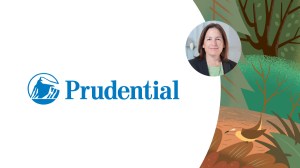For a 145-year-old insurance company, digital transformation can be a daunting task. For Prudential Financial, one of the world’s largest financial services institutions offering individual and institutional clients a wide array of financial products and services, however, the task is also a massive opportunity. Using Salesforce, the company is building a digital headquarters to improve both the customer and employee experience.
We sat down with Stacey Goodman, Prudential’s Chief Information Officer, to learn how the company is using Salesforce to digitally transform its business.
Why is Prudential embarking on a digital transformation?
Prudential, like any mature company, uses a lot of technology built in the 1960s, ‘70s, and ‘80s. Instead of just maintaining these legacy systems, we are focused on becoming more tech-forward to better meet the needs of our connected, informed, and tech-savvy customers.
There are two areas of focus for us as we embark on this effort. First is the “what,” which is improving the customer experience and the experience for employees. We’re also focusing on the “how,” so we’ve taken significant measures to provide these enhanced experiences by utilizing Salesforce online self-service.
For example, before Salesforce’s contact center solution was implemented, customers needed to call into call centers to change their beneficiary information. Now, we have an automated process where customers can do that all on their own within our system.
We’re also incorporating detailed data science techniques. Tasks that used to take days to do, like underwriting, now take seconds. With Salesforce, we’re able to build better foundational capabilities so we can deliver a faster and more innovative customer experience.
How is Prudential using Salesforce to empower customers with self-service capabilities and financial advice?
We’ve seen exponential growth in our customers wanting to be able to check their financial status often and from anywhere. To provide these best-in-class user experiences, like resetting a password quickly from a phone, we’ve incorporated DevOps capabilities, allowing for our systems to work promptly and be more agile. With this tech-forward mindset, we’re prioritizing the most important outcomes for our customers.
With these capabilities, we also empower our customers to become more financially savvy and self-serve, and we provide advisory capabilities for when customers need additional help. So, once a customer has been able to inform themselves and hone in on the financial route they’d like to take, they can speak to an advisor who can help customize plans to their needs, providing better digital experiences along with real-time advice.
What improvements have you seen from using Salesforce Financial Services Cloud?
Salesforce Financial Services Cloud has been great for us because we’ve built a holistic self-service experience, especially in our contact center where customers can do simple tasks.
We’re able to use some really cool features such as biometrics and analysis tools. Additionally, we’ve built other capabilities around artificial intelligence, machine learning, natural language clouding, chatbots, and more to further our goal of being tech-forward.
How is digital transformation helping Prudential attract talent?
The financial services and insurance industries are entirely new frontiers in terms of digital transformation.
When you look at the banking industry, it’s been differentiated and disrupted. They’re competing with each other with breakthrough technology — you don’t even have to go to an ATM anymore. Ultimately, the new banking landscape allows customers to do everything through mobile.
However, our industry — insurance and financial services — still has so much opportunity to differentiate from past working models. So with capabilities built through digital transformation, and by reinventing a 145-year-old insurance company as tech-forward, we give space for new talent to really test their skills and find new ways to solve the challenges we have with the legacy infrastructure.
To learn more, listen to Stacey’s interview on Salesforce’s IT Visionaries Podcast.















